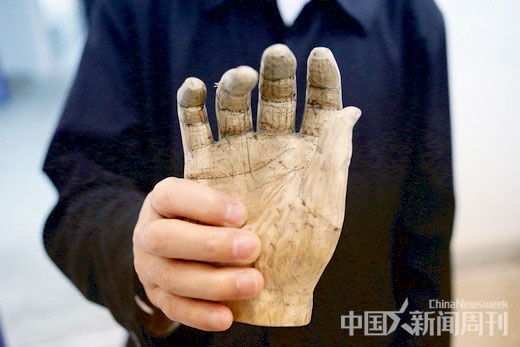

An item produced using a 3D printer.
(Ecns.cn) - 3D printing, or rapid prototyping technology, emerged in China about two decades ago, but its use in industrial manufacturing has only begun in recent years, reports China Newsweek.
Although the sector has made some achievements, China's overall level of research and development in 3D printing and commercialization remains far behind that of the United States.
In October, the Chinese Academy of Engineering (CAE) launched an investigation that will last until March next year to evaluate the future of 3D technology. When the results come out, the CAE will submit its report to the State Council.
The topic of whether 3D printing technology will spark the third industrial revolution has become the focus of attention, and experts are already calling for more government investment.
It's hard for us to catch up with the US in traditional technological domains, but in this new field we're almost at the same starting line, says Huang Weidong, a professor at the College of Materials Science and Engineering at Northwestern Polytechnic University.
With stronger government policy to encourage 3D printing development, we could probably outpace the US, Huang says.
3D Systems, the world's first 3D printing company, was founded in California in 1986. Around that time, a group of Chinese scholars studying in the US became attracted to the process of making solid 3D objects from digital models, writes China Newsweek.
Yan Yongnian, a professor at Tsinghua University, was one of those scholars. In 1988, Yan returned to China and began conducting research in the field. He soon set up a rapid prototyping center at the university and invited many scholars from the US to give lectures on 3D printing, but things proceeded slowly.
A 3D printing machine is essential to carry out practical research, but the price of such equipment was too high for Tsinghua. It was not until 1994 that the problem was finally solved through a partnership with a Hong Kong-based company that acted as an agent for 3D Systems.
After that, many other universities also joined the camp, including Xi'an Jiaotong University and Huazhong University of Science and Technology (HUST).
Wang Yungan, a professor at HUST, invented the first 3D printer using Laminated Object Manufacturing (LOM) technology in 1994. This cut material costs by half and largely shortened the production cycle of making a mould or a die.
The development of 3D printing technology in China gradually began to benefit other industries such as aeronautics/astronautics, military/defense and biomedical engineering.
In 1998, by using rapid prototyping technology in life sciences, Yan Yongnian introduced a new field of study called "biological manufacturing engineering" at Tsinghua.
Meanwhile, a team led by Huang Weidong since 2001 has applied for 12 patents in laser 3D shaping technology, which has been occasionally used in the making of aircraft engine parts in China.
However, the promotion of this advanced technology has not gone well in the country's market until recently, before which sales of 3D printers were in the single digits, notes China Newsweek.
The 3D printers that HUST produces were accepted by the market only after 2009. The university's rapid prototyping technology is now used more internationally, by European aircraft maker Airbus and the European Space Agency, for example.
But even at this point, many entrepreneurs still don't believe that machine components and parts can be manufactured without moulds and dies, says Shi Yusheng, a professor at HUST.
In 2011, China's installed 3D printer base rose to 9 percent of the world's total, still lagging behind the US. Yet China accounts for 21 percent of the world's total manufacturing value, surpassing America's 19.4 percent, reports China Daily.
Without a doubt, the US will try to regain its dominant position in manufacturing using 3D printing, as 3D printers can effectively help cut costs for manufacturers and hasten their launch of new products.
In China, however, there is still a long way to go. Hopefully the CAE's report will encourage policies for the promotion of 3D printers across the country.
Copyright ©1999-2018
Chinanews.com. All rights reserved.
Reproduction in whole or in part without permission is prohibited.